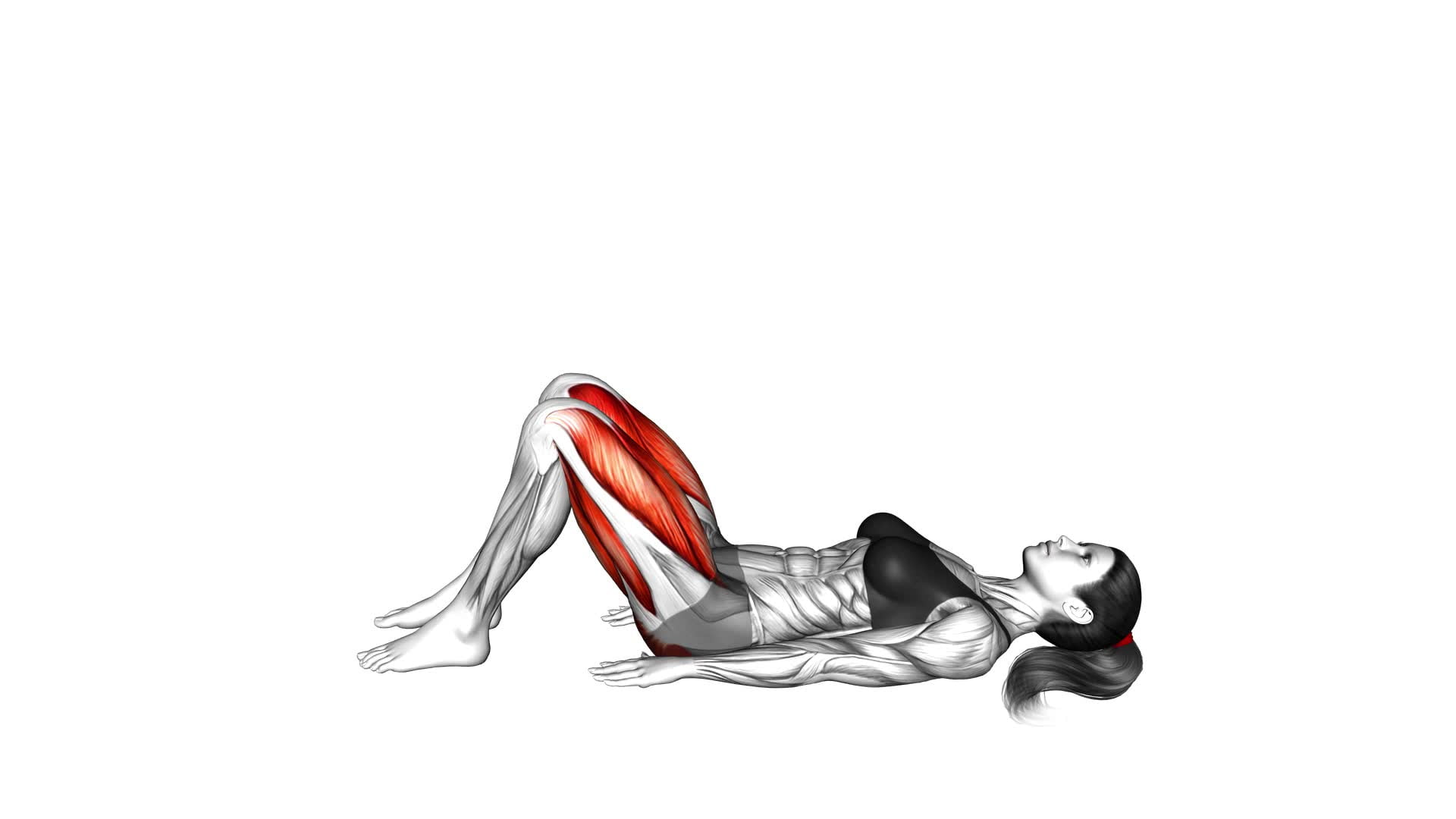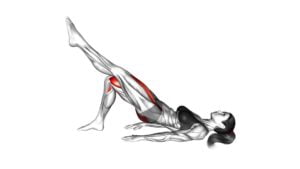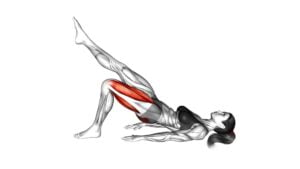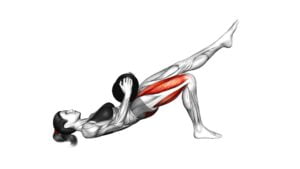Alternate Single Leg Glute Bridge (female) – Video Exercise Guide & Tips

Are you looking for a challenging exercise to target your glutes and build strength?
Watch This Exercise Video
Look no further than the alternate single leg glute bridge.
This exercise is perfect for females who want to tone and sculpt their lower body.
In this video exercise guide, we'll show you the proper form and technique, as well as modifications for beginners and advanced variations to push yourself.
Get ready to feel the burn and see results with this effective glute exercise.
Key Takeaways
- The alternate single leg glute bridge strengthens the glutes and improves lower body stability.
- It targets the glute muscles for increased strength and activates and engages them for improved stability.
- It enhances hip mobility and core stability.
- It improves overall performance in activities like running and lifting weights.
Benefits of the Alternate Single Leg Glute Bridge
One major benefit of the Alternate Single Leg Glute Bridge is that it strengthens your glutes and improves overall lower body stability. This exercise specifically targets your glute muscles, making it an excellent choice for those looking to increase glute strength. By performing the Alternate Single Leg Glute Bridge, you activate and engage your glute muscles, which helps to improve their strength and stability over time.
During this exercise, your glute muscles are the primary movers, meaning they're responsible for generating the force needed to lift your hips off the ground. As you lift one leg off the ground and extend it straight out, you're challenging your glutes even further, increasing the muscle activation and intensity of the exercise. This not only helps to improve glute strength but also enhances your overall lower body stability.
Additionally, the Alternate Single Leg Glute Bridge can also help to improve hip mobility and core stability. By engaging your glute muscles and maintaining a stable core throughout the movement, you're training your body to move efficiently and effectively. This can have a positive impact on your overall performance in activities such as running, jumping, and lifting weights.
Equipment Needed for the Exercise
To perform the Alternate Single Leg Glute Bridge exercise, you'll need a sturdy exercise mat or a comfortable surface to lie on. This will provide support and cushioning for your body during the exercise.
Additionally, you may want to consider using the following equipment to enhance your workout:
- Resistance band: Adding a resistance band around your thighs can increase the intensity of the exercise, targeting your glute muscles even more effectively.
- Dumbbells: Holding a pair of dumbbells in your hands can provide added resistance and challenge for your glutes, helping to build strength and tone.
- Stability ball: Placing your feet on a stability ball during the exercise can engage your core muscles and add an element of instability, making the exercise more challenging.
- Ankle weights: Strapping on ankle weights can add extra resistance to your leg movements, making the exercise more demanding and strengthening your glute muscles further.
- Yoga block: Placing a yoga block between your knees can help maintain proper alignment and engage your inner thigh muscles, providing a targeted workout for both your glutes and inner thighs.
Proper Form and Technique
To ensure proper form and technique during the alternate single leg glute bridge exercise, there are a few key points to focus on.
First, make sure your hips are properly aligned throughout the movement, keeping them level and avoiding any tilting or twisting.
Second, remember to breathe properly, exhaling as you lift your hips and inhaling as you lower them.
Lastly, engage your core muscles throughout the exercise to maintain stability and control.
Hip Alignment During Bridge
Ensure proper hip alignment during the bridge exercise by keeping your hips level and in line with your shoulders. Proper alignment is crucial to maximize the effectiveness of the exercise and prevent injury.
Here are some common mistakes to avoid and the importance of maintaining proper alignment:
- Avoid tilting your hips to one side, as this can put excessive strain on the lower back and hip joints.
- Keep your pelvis in a neutral position throughout the movement to engage the glutes effectively.
- Ensure that your shoulders are relaxed and not elevated, as this can create tension in the upper body.
- Engage your core muscles to stabilize the pelvis and maintain a straight line from your shoulders to your knees.
- Pay attention to your body position and make adjustments as needed to maintain proper alignment and get the most out of the exercise.
Breathing and Core Engagement
Breathe deeply and engage your core muscles for proper form and technique during the alternate single leg glute bridge exercise.
Proper breathing techniques and maintaining core stability are crucial for maximizing the benefits of this exercise and preventing injury.
As you lift your hips off the ground and extend one leg, inhale deeply through your nose, filling your lungs with air.
As you lower your hips back down, exhale slowly through your mouth, engaging your core muscles and maintaining stability throughout the movement.
This controlled breathing pattern helps you maintain proper form and alignment, while also ensuring that your core muscles are activated and working effectively.
Remember to focus on your breath and engage your core for optimal results.
Modifications for Beginners
Start with a lower resistance band to make the exercise easier. This modification is great for beginners who may not have built up enough strength to perform the exercise without assistance. By using a lower resistance band, you can still engage your glutes and work on your form without straining your muscles.
Here are some other modifications for beginners to consider:
- Use a higher surface: Start by performing the exercise on a higher surface, such as a bench or step, to reduce the range of motion and make it easier to lift your hips.
- Keep both feet on the ground: Instead of lifting one leg off the ground, keep both feet planted firmly on the floor. This will provide more stability and make the exercise less challenging.
- Use a pillow or yoga block: Place a pillow or yoga block under your hips to provide extra support and make the exercise more comfortable.
- Perform the exercise with bent knees: Instead of fully extending your legs, keep your knees bent throughout the movement. This will decrease the difficulty and allow you to focus on proper form.
- Reduce the number of repetitions: Start by performing fewer repetitions of the exercise, gradually increasing the number as you build strength and confidence.
Advanced Variations to Challenge Yourself
To further challenge yourself, try incorporating advanced variations into your single leg glute bridge exercise.
These advanced modifications will help you take your glute bridge to the next level and maximize your results.
One advanced variation is the weighted single leg glute bridge. Simply hold a dumbbell or kettlebell on your hips while performing the exercise. This added weight will increase the resistance and make your glutes work even harder.
Another advanced variation is the single leg glute bridge with a resistance band. Place a resistance band just above your knees and perform the exercise as usual. The resistance band will add extra tension to your glutes, making the exercise more challenging.
You can also try the single leg glute bridge on an unstable surface, such as a Bosu ball or a foam pad. This will require more stability and core strength, further engaging your glutes.
Remember to maintain proper form and control throughout these advanced variations.
Tips for Getting the Most Out of Your Workout
To maximize your workout and get the most out of your single leg glute bridge exercise, focus on maintaining proper form and engaging your glutes throughout the movement. Here are some tips to help you improve endurance and maximize calorie burn:
- Gradually increase the number of repetitions: Start with a comfortable number of reps and gradually add more as your strength and endurance improve. This will challenge your muscles and help you burn more calories.
- Use a challenging resistance: To make the exercise more effective, use a resistance band or place a weight on your hips. This will increase the intensity and engagement of your glutes, leading to better results.
- Control the tempo: Slow down the movement and focus on the contraction and extension of your glutes. This will increase the time under tension and stimulate muscle growth, improving endurance and calorie burn.
- Maintain proper alignment: Keep your core engaged and your body in a straight line from your head to your knees throughout the exercise. This will ensure that you're targeting the right muscles and avoiding any potential injuries.
- Incorporate other exercises: To further enhance your workout and maximize calorie burn, combine the single leg glute bridge with other lower body exercises like squats or lunges. This will create a more challenging and effective workout routine.
Frequently Asked Questions
How Often Should I Perform the Alternate Single Leg Glute Bridge Exercise?
To get the most out of the alternate single leg glute bridge exercise, it's important to find the right balance. You want to challenge yourself, but also prevent injury.
Start by performing the exercise two to three times a week, allowing for rest days in between. As you become more comfortable, you can increase the frequency.
Remember to listen to your body and make any necessary exercise modifications to ensure proper form and prevent any potential injuries.
Can I Do the Exercise if I Have Knee or Hip Pain?
If you have knee or hip pain, it's important to be cautious when doing the alternate single leg glute bridge exercise. While it may be possible to still do the exercise, it's recommended to modify it to alleviate any discomfort.
Consider using a smaller range of motion or placing a cushion under your knee for support. Always listen to your body and consult with a healthcare professional for specific modifications tailored to your condition.
Is It Necessary to Warm up Before Doing the Alternate Single Leg Glute Bridge?
Before diving into the alternate single leg glute bridge, it's important to warm up your body. Warming up has numerous benefits, such as increasing blood flow, improving flexibility, and preventing injuries. To avoid any mishaps during the exercise, make sure to engage your core, maintain proper form, and start with a lighter weight or resistance.
Can I Incorporate Weights or Resistance Bands Into This Exercise for Added Intensity?
Yes, you can definitely incorporate weights or resistance bands into the alternate single leg glute bridge to enhance the intensity of the exercise. This can be a great way to challenge your glutes and hamstrings even further.
However, it's important to start with a proper warm-up and gradually increase the weight or resistance to avoid any knee or hip pain.
Additionally, complementing this exercise with other glute and hamstring targeting exercises can be beneficial for overall lower body strength and stability.
What Other Exercises Can I Combine With the Alternate Single Leg Glute Bridge to Target My Glutes and Hamstrings?
To target your glutes and hamstrings, there are several exercises you can combine with the alternate single leg glute bridge.
Some variations of the single leg glute bridge include the weighted single leg glute bridge, where you can add dumbbells or a barbell for added resistance.
Another option is the single leg glute bridge with resistance bands, which helps to increase the intensity and activate the muscles further.
Other exercises that specifically target the glutes and hamstrings include Romanian deadlifts, hip thrusts, and lunges.
Conclusion
Incorporating the alternate single leg glute bridge into your workout routine can provide numerous benefits for your glutes and overall lower body strength. This exercise helps to improve stability, balance, and core engagement.
By following proper form and technique, utilizing the necessary equipment, and incorporating modifications or advanced variations as needed, you can maximize the effectiveness of this exercise.
Remember to consult with a fitness professional if you have any concerns or questions about incorporating this exercise into your routine.

Author
Years ago, the spark of my life’s passion ignited in my mind the moment I stepped into the local gym for the first time. The inaugural bead of perspiration, the initial endeavor, the very first surge of endorphins, and a sense of pride that washed over me post-workout marked the beginning of my deep-seated interest in strength sports, fitness, and sports nutrition. This very curiosity blossomed rapidly into a profound fascination, propelling me to earn a Master’s degree in Physical Education from the Academy of Physical Education in Krakow, followed by a Sports Manager diploma from the Jagiellonian University. My journey of growth led me to gain more specialized qualifications, such as being a certified personal trainer with a focus on sports dietetics, a lifeguard, and an instructor for wellness and corrective gymnastics. Theoretical knowledge paired seamlessly with practical experience, reinforcing my belief that the transformation of individuals under my guidance was also a reflection of my personal growth. This belief holds true even today. Each day, I strive to push the boundaries and explore new realms. These realms gently elevate me to greater heights. The unique combination of passion for my field and the continuous quest for growth fuels my drive to break new ground.







